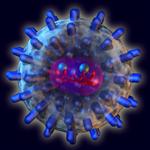 |
 |
 |
||
    |
||||
|
||||

HIV may be increasing in virulence
|
|
Reuters Health
Wednesday, April 15, 2009

These findings agree with those of other researchers, who have reported that patients starting treatment for HIV infection in recent years may have lower CD4+ cell counts at diagnosis and require antiretroviral therapy earlier in the course of disease, Dr. Nancy Crum-Cianflone, from the Naval Medical Center, San Diego, California, and colleagues report.
The study results stem from an analysis of data for 2174 patients who tested positive for HIV antibodies and were enrolled in the TriService AIDS Clinical Consortium HIV Natural History Study. None of the subjects had received antiretroviral treatment and had their CD4+ counts measured within 6 months of their HIV diagnosis. CD4+ cells are immune cells that are used to assess the severity of the infection. As HIV infection progresses, CD4+ cell counts decrease.
The average initial CD4+ cell counts during the periods 1985-1990, 1991-1995, 1996-2001, and 2002-2007 were 632, 553, 493, and 514 cells per microliter, respectively. During the same periods, the percentage of subjects with initial CD4+ cell counts below 350 cells per microliter were 12 percent, 21 percent, 26 percent, and 25 percent.
The reduction in initial CD4+ cell counts was similar in African American and in white patients, the report indicates. Similar trends were also noted for the CD4+ cell count percentage and the total count of lymphocytes, a type of white blood cell involved in the immune response.
In an accompanying editorial, Dr. Maria Dorrucci, from Istituto Superiore di Sanita, Rome, and Dr. Andrew Phillips, from University College Medical School, London, comment that while some studies, such as the current one, have suggested that HIV virulence is increasing, others have found that it is either stable or decreasing.
This, they note, may relate to how virulence is assessed, adding that "it is unclear whether simple immunological or virological proxies for virulence can be expected to adequately capture the whole complexity of HIV virulence" and the susceptibility of the patient to HIV infection.
SOURCE: Clinical Infectious Diseases, May 2009.
Reuters Health
© 2009 Thomson Reuters. All rights reserved. Reuters content is the intellectual property of Thomson Reuters or its third party content providers. Any copying, republication or redistribution of Reuters content, including by framing or similar means, is expressly prohibited without the prior written consent of Thomson Reuters. Thomson Reuters shall not be liable for any errors or delays in content, or for any actions taken in reliance thereon. "Reuters" and the Reuters Logo are trademarks of Thomson Reuters and its affiliated companies. For additional information on other Reuters media services please visit http://about.reuters.com/media/.
Related News:
More News on this Date
Related MedlinePlus Pages:
| Home | Health Topics | Drugs & Supplements | Encyclopedia | Dictionary | News | Directories | Other Resources | |
| Disclaimers | Copyright | Privacy | Accessibility | Quality Guidelines U.S. National Library of Medicine, 8600 Rockville Pike, Bethesda, MD 20894 National Institutes of Health | Department of Health & Human Services |
Date last updated: 16 April 2009 |
